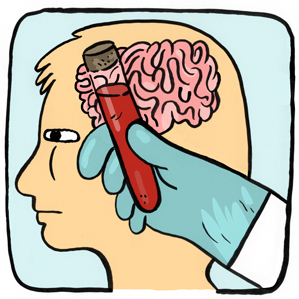Two Companies Close In on a Concussion Blood Test
A blood test that could quickly detect a brain injury and measure the damage it has done could help doctors provide better care for the millions of people suffering from such injuries, potentially improving their chances of avoiding long-term disabilities.

The trick is identifying proteins that appear in the blood in elevated amounts only after a brain injury and then developing tests that can both detect those markers and determine medically relevant information from them. Two companies, Quanterix and Banyan Biomarkers, have identified promising biomarkers and are devising and evaluating diagnostic tests.
In recent years there has been a substantial increase in research funding, thanks in large part to the Department of Defense and the National Institutes of Health, aimed at coming up with better ways to evaluate concussions, including those suffered by soldiers and athletes. Ronald Hayes, cofounder and chief science officer at Banyan Biomarkers, says that while there is still a lot of work to be done, “we are in fact on the cusp of a revolution” in understanding how to noninvasively diagnose traumatic brain injury using both blood biomarkers as well as new imaging techniques.
Hayes says that until relatively recently, the consensus in the scientific community was that it was not worth pursuing blood tests because the “blood-brain barrier” was thought to prevent telltale molecules from moving from the brain to the blood. Newer research has shown that this is not always the case, and that brain injury can lead to dysfunction of this barrier.
Banyan’s researchers have identified two proteins, and have shown that in the hours after a brain injury, concentrations in the blood are elevated in ways that correspond with the severity of the injury. The company is now in the midst of a clinical trial involving 2,000 patients, and is seeking FDA approval for a test that would use measured levels of one or both of these proteins to determine whether further evaluation via a CT scan is needed. “We can probably reduce more than a third of unnecessary CTs,” says Hayes.
A major challenge to developing biomarker-based blood tests for TBI is that the candidate proteins are present only in very low concentrations and can be difficult to detect and measure, especially after a mild concussion, says Kevin Hrusovsky, CEO of Quanterix. The company claims its technology for detecting biomarkers in the blood requires only a single target molecule to generate a signal, whereas conventional systems need millions of molecules.
Quanterix’s researchers are evaluating different candidate biomarkers, including some proteins that are associated with Alzheimer’s disease in addition to brain injuries, and both of the biomarkers Banyan is using. The two companies are “working closely” on certain research projects, says Hrusovsky, who says that the sensitivity of his company’s technology will be crucial to a better understanding of how all of the various candidate biomarkers can be used in the clinical setting.
Developing tests that go beyond diagnosis to do things like assess the risk of long-term damage will require a better grasp of the way the levels of these marker proteins change over time after an injury. Each marker differs in the degree to which its concentration increases in the blood after the injury, the speed the concentration increases, and the length of time the elevated concentration lasts. It would also require expensive long-term studies. “It’s much easier to discover a biomarker than to understand its clinical utility,” says Hayes.
Given that it is common for physicians to use biomarkers to assess damage in other organs, brain injury biomarkers are overdue, says Patrick Kochanek, a critical care physician and professor at the University of Pittsburgh School of Medicine. He says several of the biomarkers under development “give us a decent view of severity,” and could soon be giving doctors valuable information that can help elucidate the most appropriate course of care. Blood biomarkers could also help researchers and physicians better understand the link between brain injury and neurodegenerative disease, says Kochanek.
Hrusovsky says his company is considering developing a handheld device that could assess the severity of an injury on the sideline of a football game. He says it should be possible to bring such a device to market by the end of 2017, but to pull that off Quanterix might need the help of an industry partner to help pay for expensive clinical trials. In the meantime, he says, it is realistic that a so-called laboratory developed test, which could not be administered on the sideline but is subject to fewer regulatory hurdles, could be ready within six months.
Keep Reading
Most Popular
Large language models can do jaw-dropping things. But nobody knows exactly why.
And that's a problem. Figuring it out is one of the biggest scientific puzzles of our time and a crucial step towards controlling more powerful future models.
The problem with plug-in hybrids? Their drivers.
Plug-in hybrids are often sold as a transition to EVs, but new data from Europe shows we’re still underestimating the emissions they produce.
Google DeepMind’s new generative model makes Super Mario–like games from scratch
Genie learns how to control games by watching hours and hours of video. It could help train next-gen robots too.
How scientists traced a mysterious covid case back to six toilets
When wastewater surveillance turns into a hunt for a single infected individual, the ethics get tricky.
Stay connected
Get the latest updates from
MIT Technology Review
Discover special offers, top stories, upcoming events, and more.